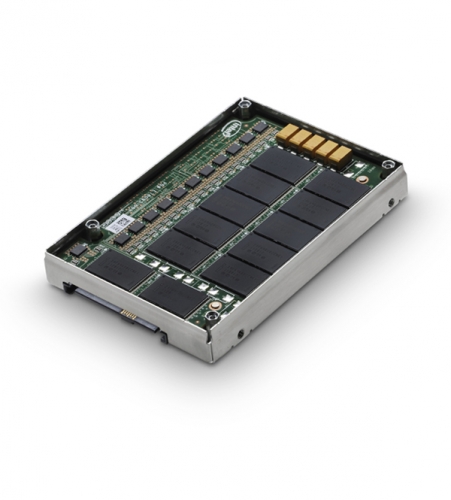by Kristian Vättö on 2/8/2012 1:35:00 PM
Posted in Storage , SSDs , Hitachi , Hitachi GST , IT Computing 
25nm MLC NAND has been in the market for roughly a year now and it is very common in today's consumer SSDs—there are only a few models using 3Xnm MLC NAND (OCZ Vertex 3 Max IOPS for example). In the enterprise space, however, 25nm SLC NAND is just starting to appear in SSDs. Hitachi GST (i.e. Hitachi's storage unit) today released their Ultrastar SSD400S.B series, which is the first publicly available SSD to use 25nm SLC NAND.
Before we look at the specifications of Hitachi's new enterprise SSD, let's go through the reasons why we haven't seen 25nm SLC NAND before today. There is no physical difference between SLC and MLC; manufacturing SLC NAND isn't any harder than manufacturing MLC NAND. The only real difference between SLC and MLC is the fact that SLC stores one bit per cell whereas MLC stores two, although this has nothing to do with why 25nm SLC NAND is released later than 25nm MLC NAND. When you shift to a new process node (from 34nm to 25nm in this case), the first NAND to be manufactured is MLC. Why?
MLC is the highest volume product and it's usually not used by enterprises, so extreme reliability is not necessary. SLC NAND is very enterprise orientated due to its higher cost per GB, making its volume smaller. Every time you move to a new process node, your yields will be lower than on the old node. Only when you have met the demand of 25nm MLC NAND and the process has matured enough—not just better yields, but the higher reliability that is essential for enterprise market—can you start manufacturing 25nm SLC NAND along with your MLC NAND. This time, it took about a year for the 25nm process to be mature enough for SLC, and 20nm MLC NAND is already knocking at the door.
With the short NAND flash lesson out of the way, it's time to look at this new SSD. Hitachi's Ultrastar SSD400S.B comes in a 2.5" form factor but it's important to note that its height is 15mm, making it too thick for most laptops—this is aimed at servers, after all. It uses Intel's 25nm SLC NAND and a SAS 6Gb/s interface, which isn't used in the consumer space but offers some crucial features for servers (e.g. more effective error-recovery). The actual controller seems to have been developed in-house, but Hitachi has been very quiet on that so unfortunately we don't have any details. Another possibility is a third party controller (e.g. SF-2582) with Hitachi's own firmware. Either way, we are looking at a fairly high performance controller with SandForce-like performance, at least going by the spec sheet.
Hitachi Ultrastar SSD400S.B SpecificationsInterfaceSAS 6Gb/sSequential Read536MB/sSequential Write502MB/sRandom Read57.5K IOPSRandom Write25.5K IOPSThe Ultrastar SSD400S.B will be available in capacities of 100GB, 200GB, and 400GB. Hitachi has not revealed the pricing but given that this is an enterprise-grade SLC SSD, the price tag won't be wallet friendly. Hitachi has already started shipments to selected OEMs and widespread availability is expected later in H1'12.
Source: Hitachi
Maybe it's possible to figure out if they've bought a 3rd-party controller with a little bit of deductive reasoning. :)
http://www.zdnet.co.uk/news/storage/2011/08/09/hit...
EMC has been using their prior SLC models for some time with solid reliability and performance.
They also make a MLC model.
You just don't hear about these on the enthusiast sites as not the intended market.
Not a coincidence that the enterprise products are only pretty much coming from companies that are absolute behemoths in the IT space (Intel, Seagate, Hitachi, etc)..
But the current SLC cost 3 to 4 times as much.........
1. SLC enters production later so most of the time, you will have SLC based on older process node. That means bigger die size or smaller capacity, which means you get less capacity out of a single wafer, making manufacturing more expensive. For example now, all SLC SSDs have been based on 3Xnm NAND, while MLC SSDs are mainly 2Xnm.
2. While the actual manufacturing is the same, the quality is not. Just like in CPU manufacturing, some of the dies are higher quality than the other - after testing, one is sold as i5-2400 while other is sold as i7-2600. This is the same with NAND, not every die is the same. Since SLC is solely for enterprise, it needs to be high quality. It needs to withstand higher temperatures (this affects the P/E cycles) and be good enough for enterprise load. So while SLC and MLC dies can come from the same wafer, I would suspect that the best dies are picked for SLC production. Of course, there are Grade 1, Grade 2 etc. but I think OEMs that use SLC SSDs want the highest quality, not some cheap stuff.
3. SLC based SSDs often deploy enterprise-grade controllers and firmwares. They are more expensive than their mainstream counterparts so that raises the total price of the SSD as well. Also, enterprise-grade SSDs tend to go through stricter validation process to ensure that it's bug free, which isn't free either.
There will also be a TLC (triple-level cell) NAND article out soon, which will talk about NAND manufacturing a bit more :-)

User Name Password Remember me? Login
 1 2 Next » View All Comments Post a Comment
1 2 Next » View All Comments Post a Comment Copyright © 1997-2012 AnandTech, Inc. All rights reserved. Terms, Conditions and Privacy Information.
Click Here for Advertising Information





0 comments:
Post a Comment